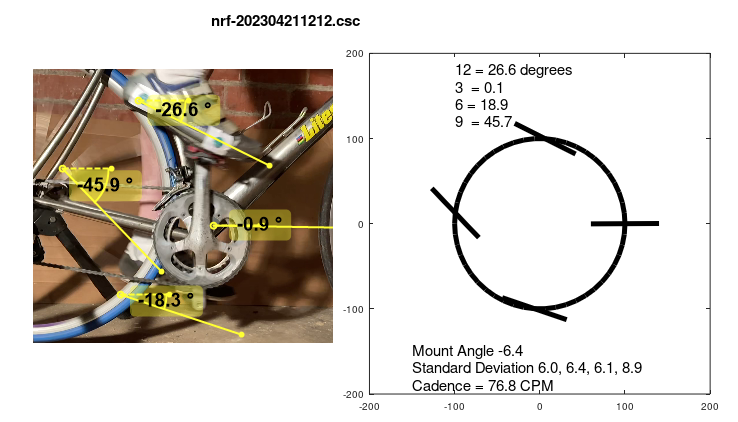Introduction
I’m a retired engineer who likes to ride bike. Over the past 22 years of recreational biking I have several questions:
- Why are my pedal angles so different from other riders?
- Is there a way to get more useful data with lower cost monitoring devices?
- Could a new kind of monitoring device better help individuals and professional bike fitters?
- Can a device signal bad riding habits during a ride (possibly helping me avoid foot pain)?
To try answering these questions I built monitoring devices. To keep the cost low, and make it easy to use, I looked at a simple motion sensor (3 accelerometer and 3 gyros). My latest device looks, and can operate very similar to the Garmin Cadence Sense 2. This device can mount on the bicycle crank and transmit cadence measurements using the Cycling Speed and Cadence Bluetooth LE profile. In addition to measuring cadence I believe I can also accurately measure pedal pitch, tilt, rotation and crank speed variations (if the sensor is mounted on the foot instep).
Pedal Angles, Pedaling Smoothly, Shoe Tilt and Rotation, Crank Arm Velocity Smoothness:
Pedal angle pitch is often referenced by four points of interest during the pedal rotation, sometimes referred to as four locations on the hands of an analog clock. Twelve o’clock is also called Top Dead Center (TDC), three o’clock can be called Right Horizontal (RH), six is Bottom Dead Center (BDC), and 9 is Left Horizontal (LH).
A pedal angle Smart Phone application displays real-time pedal angles on each pedal stroke. Pedal positions marked in red indicate pedal angles outside a desired range (specified in a user modifiable text file). The “Ride Summary” screen button displays averages for the entire ride; the “Save And End button" saves this data and ends the program.
Another Smart Phone application shows the rider how well the pedal motion matches an ideal of smoothness. An uneven pedal motion is sometimes referred to as having dead spots. This program refers to pedal smoothness as pedal efficiency.
In addition to real-time performance display, continuous data from all six sensors is saved for post-ride analysis.
Pedaling efficiency can be played back from any point in the ride.
Foot tilt and rotation is best measured while riding a stationary bicycle (excluding bike weaving and rocking motion when riding on the road or a trail). Tilt sensing includes gravity for an accurate measurement. Rotation has no gravity reference and is a relative measure.
Foot pitch, tilt and rotation data can be viewed in several ways, including computer animation (which can isolate individual data streams). View angle can be changed with the mouse when viewing with the animator.
Combined, Rotation only, Tilt only GIFs
Crank Arm Velocity Smoothness (Work In Progress)
One way to measure circular speed is to plot the vertical and horizontal accelerometer signals together. These signals not only contain velocity, but also show pedal angle changes, and other motion noise (such as shoe flexing).
Here are two charts of the same pedal stroke. The second chart has pedal angles mathematically removed. The center black circle represents pedal angle at zero degrees. Distance between spokes (sensor sample points) is proportional to speed – larger separation means greater velocity and/or foot angle changes. Rotation speed and speed variations can be determined by distance between the spokes.
Another way to measure circular speed is to mount the sensor on the bicycle crank arm. Sensor data is compared with total rotation time sine wave.
Smooth rotation motion at 2.4% variation.
Not so smooth rotation motion at 11% variation.
What I have learned so far
- Why are my pedal angles so different from other riders? Although my sample size of other riders is very small, it is definitely the case that pedal angles between riders can be significantly different. I’m hoping to collect pedal angle data from many riders. I have hand-built a small number of devices for monitoring this summer 2022.
- Is there a way to get more useful data with lower cost monitoring devices? Unless I develop more automation and analysis tools I believe my device is too complex for casual riders and too simple for professional bike fitters.
- Could a new kind of monitoring device better help individuals and professional bike fitters? The pedal position data helped me adjust my bike, but I felt the need to also change the way I pedal. The run-time display was engaging and extremely helpful. I can see my pedaling has changed and believe I have improved.
- Can a device signal bad riding habits during a ride (possibly helping me avoid foot pain)? To be determined.
I hope to learn much more in the coming months. I will try to post updates, but I don’t expect to have better answers until the fall of 2022. –Bryan
see also:
https://bicyclepedalmonitoring.blogspot.com/2022/04/questions-and-answers.html
https://bicyclepedalmonitoring.blogspot.com/2022/05/q-how-accurate-is-this-thing.html
https://bicyclepedalmonitoring.blogspot.com/2022/05/q-my-seat-position-is-finewhat-else-can.html

Wow. Impressive. Hope you continue to move forward with the project
ReplyDelete